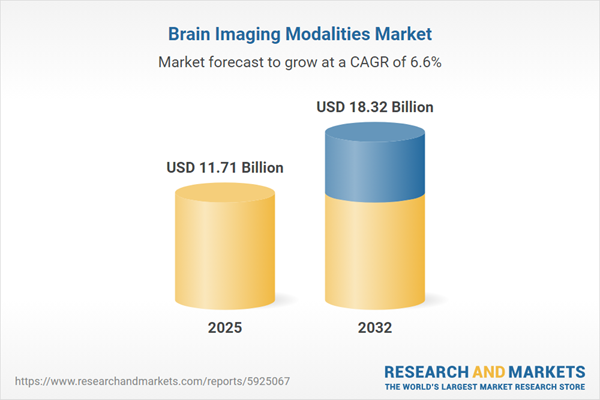Speak directly to the analyst to clarify any post sales queries you may have.
The brain imaging modalities market is evolving rapidly as technology and clinical demands transform diagnostics, research, and patient monitoring. For executive leaders navigating complex decisions, understanding competitive, regulatory, and technological trends is essential to identify opportunities and mitigate risks.
Market Snapshot: Brain Imaging Modalities Market Size and Growth
The brain imaging modalities market grew from USD 10.99 billion in 2024 to USD 11.71 billion in 2025. The sector is expected to continue expanding at a CAGR of 6.58%, reaching USD 18.32 billion by 2032. This reflects steady global adoption across clinical, research, and therapeutic domains as innovation accelerates. Increasing demand for advanced diagnostics, rising neurological disease prevalence, and expanding use in pharmaceutical development drive continued growth.
Scope & Segmentation
This report delivers comprehensive analysis across technology types, application areas, end users, regions, and the competitive landscape. Major segments include:
- Modality: Computed tomography (including cone beam and conventional), magnetic resonance imaging (with subtypes angiography, diffusion, functional, structural), optical imaging (functional near-infrared spectroscopy, optical coherence tomography), positron emission tomography (Amyloid, Dopamine, FDG), single photon emission computed tomography (focused on dopamine transporter), and ultrasound imaging (biomicroscopy, transcranial doppler).
- Application: Diagnostics (epilepsy, neurodegenerative disorders, traumatic brain injury, tumor detection, vascular disease); research (brain mapping, neuroscience—basic and clinical, pharmaceutical development); therapeutic monitoring (disease progression tracking, surgical monitoring, treatment response assessment).
- End User: Academic institutions (medical schools, universities), ambulatory care facilities, diagnostic centers, home healthcare, hospitals, research institutes (government and private labs).
- Region: Americas (North America—United States, Canada, Mexico; Latin America—Brazil, Argentina, Chile, Colombia, Peru), Europe, Middle East & Africa (including UK, Germany, France, Russia, Italy, Spain, Netherlands, Sweden, Poland, Switzerland, UAE, Saudi Arabia, Qatar, Turkey, Israel, South Africa, Nigeria, Egypt, Kenya), and Asia-Pacific (China, India, Japan, Australia, South Korea, Indonesia, Thailand, Malaysia, Singapore, Taiwan).
- Leading Companies: Siemens Healthineers AG, General Electric Company, Koninklijke Philips N.V., Canon Inc., Hitachi Ltd., Fujifilm Holdings Corporation, Shimadzu Corporation, Neusoft Medical Systems Co., Ltd., Samsung Electronics Co., Ltd., Bruker Corporation.
Key Takeaways: Strategic Insights for Senior Decision-Makers
- Recent hardware and software integration advances support the trend toward multimodal, high-resolution imaging, optimizing clinical and research outcomes.
- Growing roles for artificial intelligence and machine learning in brain imaging are expanding diagnostic capabilities and enabling data-driven, personalized medicine approaches in neurology and psychiatry.
- Segmentation analysis highlights demand for modality-specific solutions, from functional near-infrared spectroscopy in optical imaging to hybrid PET/MRI and transcranial doppler applications for bedside monitoring.
- Regional dynamics are driving variable adoption, with established healthcare infrastructures in the Americas and Europe supporting innovation, while Asia-Pacific sees rapid scaling of public health investments and local manufacturing partnerships.
- Industry strategies increasingly focus on modular, upgradable systems, portfolio diversification into analytics and service models, and expanded geographic presence through regional research and development facilities as well as targeted acquisitions.
- Stakeholder collaboration, including device manufacturers, pharmaceutical companies, academic research centers, and healthcare institutions, remains essential for both evidence generation and competitive differentiation.
Tariff Impact on Supply Chains and Procurement
U.S. tariffs introduced in 2025 have raised procurement costs for imaging component manufacturers with global supply chains. Companies dependent on imported coils and precision parts have adapted by sourcing alternatives, localizing operations, or reengineering logistics to maintain competitive pricing. This shift is fostering regional self-sufficiency, prompting critical evaluation of reshoring strategies, modular production, and diversified supplier bases, enabling greater resilience and continuity amid changing trade environments.
Methodology & Data Sources
This research integrates primary interviews with neurologists, radiologists, and engineers; secondary analysis of peer-reviewed literature; and systematic tracking of regulatory filings and patent data. Rigorous quality assurance protocols, such as data triangulation and validation by subject matter experts, ensure all insights are robust and actionable for strategic planning.
Why This Report Matters
- Gain clear guidance to support investment, R&D, and procurement decisions in a dynamic neurodiagnostics landscape.
- Anticipate and manage supply chain, regulatory, and competitive risks to enhance market positioning and operational continuity.
- Accelerate evidence-based innovation by leveraging holistic insights across regional, technological, and end-user trends.
Conclusion
The brain imaging modalities market is defined by technology integration, regional opportunity, and regulatory complexity. Senior leaders equipped with data-driven insights and agile strategies will be better positioned to drive successful innovation and business growth in a dynamic healthcare environment.
Additional Product Information:
- Purchase of this report includes 1 year online access with quarterly updates.
- This report can be updated on request. Please contact our Customer Experience team using the Ask a Question widget on our website.
Table of Contents
3. Executive Summary
4. Market Overview
7. Cumulative Impact of Artificial Intelligence 2025
Companies Mentioned
The companies profiled in this Brain Imaging Modalities market report include:- Siemens Healthineers AG
- General Electric Company
- Koninklijke Philips N.V.
- Canon Inc.
- Hitachi Ltd.
- Fujifilm Holdings Corporation
- Shimadzu Corporation
- Neusoft Medical Systems Co., Ltd.
- Samsung Electronics Co., Ltd.
- Bruker Corporation
Table Information
| Report Attribute | Details |
|---|---|
| No. of Pages | 181 |
| Published | October 2025 |
| Forecast Period | 2025 - 2032 |
| Estimated Market Value ( USD | $ 11.71 Billion |
| Forecasted Market Value ( USD | $ 18.32 Billion |
| Compound Annual Growth Rate | 6.5% |
| Regions Covered | Global |
| No. of Companies Mentioned | 11 |









